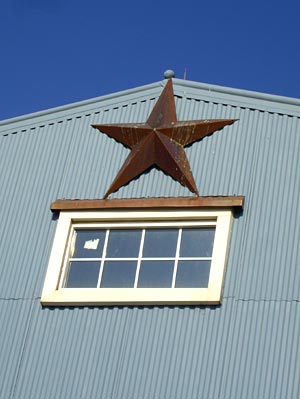Copper Artist Burt Squires Revives the Historic Barn Star
 Copper Artist Burt Squires in his studio
Copper Artist Burt Squires in his studioPhotograph by Paul David
After more than 17 years as an aerospace engineer, working on projects ranging from the Space Shuttle to the Mars Rovers, artist Burt Squires found a creative way to dovetail his passion for space with his love of working with copper. His East Berlin, PA studio has copper accents in unexpected places, from the copper spouting to a giant cupola on top of his home. Squires's artist ambitions combined with his astrophysicist background catapulted him to an unexpected success, and today, he is one of the United State's most recognized copper craftsman.
"What emerged from this unlikely marriage was The Copper Star," says Squires. "What began as a simple quest to spend more time with my two, now three, young children has blossomed into a thriving business with customers in every state and five foreign countries."
According to Squires, the tradition of barn stars date back to the early 1800s, when barn builders would create a trademark star that was unique to the builder of the barn. Originally popular in Pennsylvania due to the state's German settlers, barn stars grew in popularity across the US after the American Civil War, but no one is entirely sure why. One theory for their increased popularity may be traced back to the great East Coast earthquakes of 1884 and 1886, which hit 15-miles offshore of New York City. Although no buildings were demolished, many masonry buildings along the East Coast required reinforcements to make them structurally sound.
"The predominate technique at the time was to install a series of threaded rods called earthquake bolts that spanned the length of the building," says Squires. "The ends of these rods protruded to the buildings exterior (often in gable ends) and were capped off with a large threaded nut-in the shape of a star! Stars were chosen because they were already commonplace on the gable ends of buildings. As a result, stars became elements of both form and function."
Squires chose copper to create his barn stars because of its natural durability and beauty, and has now has expanded his repertoire to include copper clocks and home décor items such as copper garden art, house numbers and wall accents.
 Burt Squires's copper barn stars
Burt Squires's copper barn starsPhotograph by Paul David
"I had never worked with copper before-I taught myself the trade. Copper is such a nice material to work with; it can be easily shaped and formed," says Squires. "What is so amazing about copper is the oxidation itself (turning green) that yields its extreme longevity. In contrast, oxidation (rust) is what leads to the demise of steel."
All of Squires's stars start out as flat sheets of copper, on which he forms the 5 separate points before joining the stars together using hand-hammered copper rivets or bolts. To achieve the "architectural grade" quality of his work, he uses 20 oz. copper for all of his copper products. Squires developed his own machinery to produce and manufacture his copper stars, with a little help from his astrophysicist background.
Squires says that he started his business serendipitously, when trying to find a copper star that would last on his East Berlin barn. "I was very concerned that a steel star would rust and cause rust bleeding on my barn and stone foundation," says Squires. "This type of damage was quite evident in steel star installations in my area. After having no luck finding a copper star, I decided to make my own. Having figured out how to make the two I needed, it seemed a shame to stop. Five years later I can comfortably say that I have made thousands of them."
Between his copper stars and his aerospace pursuits, Squires has an ongoing astronomical theme in his life, and is currently an engineer on the 2020-manned mission to the moon project.
"Stars, in one way or another, have been a constant thread in my career," says Squires. "Although I have been involved the many cutting edge technology projects, I think my copper stars will be my most enduring legacy. In my opinion, no one will ever throw away a copper star; I really think my stars will be hanging on walls for hundreds of years to come."
Resources:
Also in this Issue:
- Artists and Alchemists: The Art of Copper Electroforming
- Copper Artist Burt Squires Revives the Historic Barn Star
- Martino Hoss and Pastel on Copper: Vignettes of a Memory
- Honoring the Bronze Bas Relief at the Base of Provincetown's Pilgrim Monument
- New Gallery for Native North American Art Opens at Metropolitan Museum, Rare Copper Mask on Display
